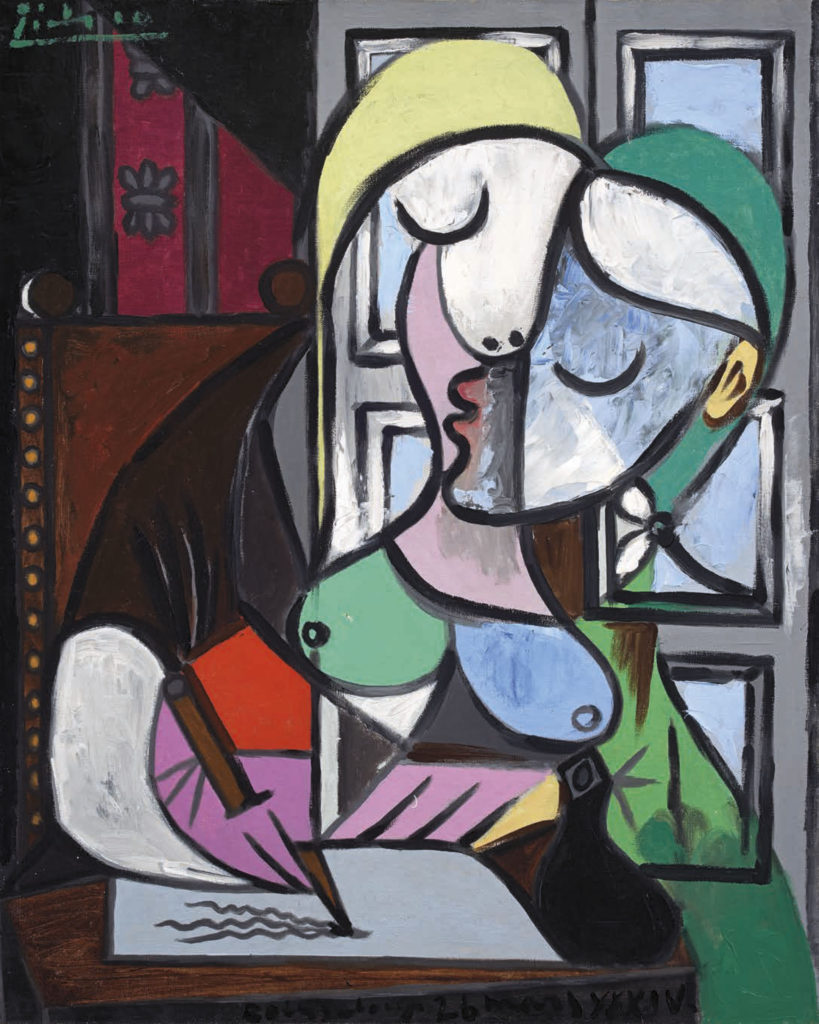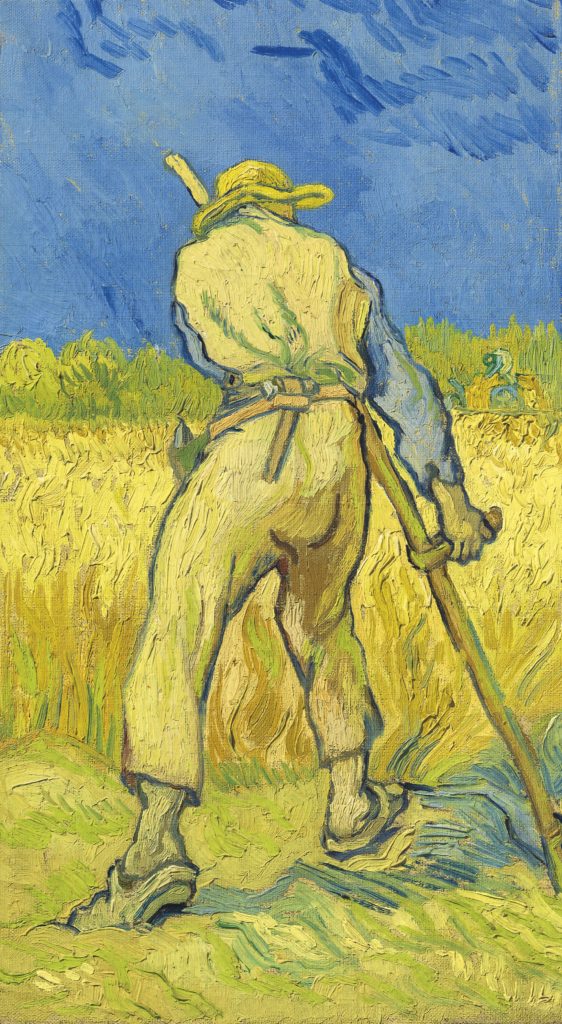
Pablo Picasso (1881-1973), Femme écrivant (Marie-Thérèse), signed ‘Picasso’ (upper left); inscribed and dated ‘Boisgeloup 26 mars XXXIV.’ (along the lower edge), oil on canvas, 31 7/8 x 25 1/2 in. (80.9 x 64.7 cm.), Painted in Boisgeloup on 26 March 1934, Estimate £30,000,000 – 40,000,000 British pounds ©Succession,Picasso/DACS, London 2017
Powered by a trio of paintings that each fetched in excess of £20 million, Christie’s Impressionist and Modern evening sale in London tallied a healthy £149.5/$190.3 million.
Only two of the 32 lots offered failed to sell for a stellar buy-in rate by lot of six percent.
The total, including fees, fell just above the low-end of pre-sale expectations of £141.3-191.7/$179.5-243.4 million.
Nineteen of the 30 lots sold went for over a million pounds and 23 hurdled a million dollars.
The result easily trumped last June’s decidedly puny £25.6/$37.5 million same category auction for the 21 lots that sold.
Tonight three artist records were set including a stunning and rare to market Max Beckmann painting from 1937-38 that doubled the previous mark.
Only four of the offerings, including the cover lot Vincent van Gogh, were backed by either house or third party guarantees.
Christie’s result outgunned arch-rival Sotheby’s equivalent evening auction held last week in London that made £127.9/$161.3 million and that included Wassily Kandinsky’s record setting “Bild mit weissen Linien (Painting with White Lines)” from 1913 that fetched £33/$41.6 million.
Prices reported include the hammer price plus the added on buyer’s premium for each lot sold calculated at 25 percent of the hammer price up to and including £100,000, 20 percent on that part of the hammer price over £100,000 and up to and including £2 million and 12 percent for anything over that.
Estimates do not include the buyer’s premium.
The total hammer hit £130.8/$166.5 before fees.
The evening got off to a modest start with Pablo Picasso’s sweet still life, “Les gateaux” from 1937, a petite 6 5/8 by 8 ¾ inch oil on canvas that sold for £365,000/$464,645 (est. £300-500,000) and Georges Braque’s Cubist style still life with playing cards, “Les deux as” from 1929, at a slightly larger 9 5/8 by 13 ¾ inch oil on canvas that made £341,000/$434,093 (est. £300-400,000).
The Braque last sold at Christie’s New York in May 2006 for $668,000, so not a profitable result in retrospect.
Continuing in that warm-up, small format vein, Rene Magritte’s cloud covered and convincingly enigmatic composition, “L’embellie” from 1962 at 12 7/8 by 10 ¼ inches in gouache on paper and the sole Surrealist offering of the evening, sold to Greek collector Dimitri Mavrommatis for an estimate busting £1,061,000/$1,350,653 (est. £450-550,000).
Early standouts included the grid-like, Mondrian influenced and De Stijl styled Georges Vantongerloo oil on canvas from 1930, “Composition dans le carre avec couleurs jaune-vert-bleu-indigo-orange” that sold to the telephone for a record £1,085,000/$1,381,205 (est. £350-450,000) and Hannah Hoch’s searing and biographic figurative work about a lost affair, “Frau and Saturn” from 1922 that went for a record (and identical) £1,085,000/$1,381,205 (est. £400-600,000).
The first heavy hitter and cover lot, Vincent van Gogh’s sun splashed reaper, “Le moissonneur (d’apres Millet),” painted in Saint-Remy in1889 and virtually a homage like copy of a Jean-Francois Millet painting, sold for £24,245,000/$30,863,885 (est. £12.5-16.5 million).

Vincent van Gogh (1853-1890), Le moissonneur (d’après Millet), oil on canvas, 17 x 9 5/8 in. (43.3 x 24.3 cm.), Painted in Saint-Rémy in 1889 Estimate 12,500,000-16,500,000 British pounds
Bidding started at £9 million and quickly escalated at one million pound increments to £15 million, and then dropping back to £500,000 bid jumps, all the way to the £21.5 million winning hammer price from an anonymous telephone bidder.
It was backed by a house guarantee.
The toiling field hand action portrait last sold at Sotheby’s London in June 1995 for £2.5 million and is one of nine works van Gogh painted in the Millet style.
In the wake of the high-achieving van Gogh, Pablo Picasso’s iconic homage to his muse and lover, “Femme ecrivant (Marie-Therese)” from March 1934 sold without much ado to a telephone bidder for £34,885,000/$44,408,605 (est. £30-40 million).
Xin Li, deputy chairman of Christie’s Asia manned that telephone line.
Marie-Therese is captured in intimate concentration, pen in hand and multi-hued in Picasso’s painted light.
It was once owned by the storied New York art collector and dealer duo, Daniel and Eleanore Saidenberg.
But the top gun of the sixty-minute evening sale went to Max Beckmann’s astonishingly frightening, narrative masterpiece, “Holle der Vogel (Birds’ Hell)” from 1937-38 that sold to dealer Larry Gagosian for a record-shattering £36,005,000/$45,834,365.
It crushed the previous mark set by Beckmann’s “Selbbildnis mit horn” from 1938 that sold at Sotheby’s New York in May 2001 for $22,555,750.
Tonight’s masterpiece, channeling all the horror of a Hieronymous Bosch painting but modernized by the then contemporaneous and murderous work of the Nazi war machine creates a chilling parable, sharp beaked birds carving into human flesh, bound and helpless.

Max Beckmann (1884-1950), Hölle der Vögel, oil on canvas, 47 1/8 x 63 1/8 in. (119.7 x 160.4cm.), Painted in 1937-1938
The painting was last exhibited at the Metropolitan Museum in New York, “Max Beckmann in New York” from October 2016-February 2017.
The wall label identified the owner as Richard Feigen, the celebrated New York dealer.
A trust set up to benefit his children and grandchildren placed the painting at auction.
The property title in the catalogue simply stated, “Property from a Private American Collection.”
Reached by phone shortly after the sale, Feigen, who watched the auction from the fifth row in the salesroom, sounded bittersweet. “It didn’t bring what I hoped, I was hoping for a lot more. I’m disappointed to lose it. I’ve had it for thirty-five years.”
The dealer, whose long owned Orazio Gentileschi painting, “Danee,” also placed at auction by the family trust, sold to the Getty Museum for a record $39.5 million at Sotheby’s New York in January 2016, explained how he acquired the Beckmann.
“The first time I thought I acquired it was in 1954 from the Curt Valentine Gallery but Stephen Radich (a fellow New York art dealer) snatched it from me,” recalled Feigen. “I eventually bought it from Morton May in 1983 for $500,000. May was always my main competitor for Beckmann.”
Valentine specialized in showing so-called German Degenerate Art from the Nazi era, a group that Beckmann was inextricably linked to.
Asked about the significance of the work, Frances Beatty of the New York art advisory Adler Beatty and who directed Feigen’s gallery for decades before it closed shop, said, “it is an amazing, great and monumental painting of the 20th century, in every way.”
Other highlights ranged from Amedeo Modigliani’s richly provenanced and early interpretation of a Greek stone carving, “Cariatide” from 1913, executed in oil on canvas that sold for £6,885,000/$8,764,605 (est. £6-9 million) and Claude Monet’s “Saule pleureur” from 1918-19, a weeping willow from his water garden and stamped with his signature, sold for £8,901,000/$11,330,973 (est. £15-25 million).
That’s not a typo regarding the sky-high and unobtainable estimate, by the way, just the reality of a seller eager to offload a picture.
The standout casualty of the evening was an important and large-scale Egon Schiele landscape, “Einzeine Hauser (Hauser mit Bergen) (recto)” from 1915, exhibited in the epoch making Vienna Secession exhibition of 1918.
It bought in at a chandelier bid £19.5 million against the £20-30 million estimate.
The picture last sold at Christie’s New York in November 2006 for a then torrid $22.4 million.
“The only calamity was the Schiele,” said Guy Jennings, the London based managing director of the Fine Art Group, “I thought it didn’t quite sing. The market,” continued Jennings, referring to the Impressionist and Modern field, “is certainly not bubbling hot.”
An outlier of the evening, as if it dropped in from another planet, Lucio Fontana’s single slashed canvas in fire engine or Ferrari red, “Concetto spaziale, Attese” from 1964, sold to the telephone for £1,445,000/$1,839,485.
Normally, the Fontana would be featured in a Christie’s Post-War/Contemporary sale but the house didn’t organize one for this season.
“We had an amazing sell-through rate,” said Jay Vincz, Christie’s London head of Impressionist and Modern art, “it was a tightly put together sale and in the end, really paid off.”
The evening action continues tomorrow at Sotheby’s contemporary art sale.